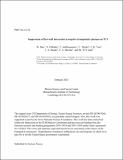| dc.contributor.author | Han, Woonghee | en_US |
| dc.contributor.author | Offeddu, N. | en_US |
| dc.contributor.author | Golfinopoulos, T. | en_US |
| dc.contributor.author | Theiler, C. | en_US |
| dc.contributor.author | Tsui, C.K. | en_US |
| dc.contributor.author | Boedo, J.A. | en_US |
| dc.contributor.author | Marmar, E.S. | en_US |
| dc.contributor.author | TCV Team | en_US |
| dc.date.accessioned | 2025-03-21T20:19:30Z | |
| dc.date.available | 2025-03-21T20:19:30Z | |
| dc.date.issued | 2021-02 | |
| dc.identifier | 21ja076 | |
| dc.identifier.uri | https://hdl.handle.net/1721.1/158679 | |
| dc.description | Submitted for publication in Nuclear Fusion | |
| dc.description.abstract | Magnetically confined fusion plasmas with negative triangularity (d) exhibit greater L-mode confinement than with positive d. Recent experiments in the TCV and DIII-D tokamaks have correlated the confinement improvement to a reduction of fluctuations within the plasma core. We report on fluctuation measurements in the scrape-off layer (SOL) for −0.61 < d < +0.64 in limited and diverted ohmic L-mode plasmas; these reveal a strong reduction in SOL fluctuation amplitudes at d < −0.25, and, surprisingly, an almost full suppression of plasma interaction with the main-chamber first-wall, which could have important implications for the prospects of using negative d plasmas as a reactor solution. An exploration of several physical mechanisms suggests that a reduced connection length—intrinsic to negative d plasmas—plays a critical role in the origin of this phenomenon. | |
| dc.publisher | IOP | en_US |
| dc.relation.isversionof | doi.org/10.1088/1741-4326/abdb95 | |
| dc.source | Plasma Science and Fusion Center | en_US |
| dc.title | Suppression of first-wall interaction in negative triangularity plasmas on TCV | en_US |
| dc.type | Article | en_US |
| dc.contributor.department | Massachusetts Institute of Technology. Plasma Science and Fusion Center | |
| dc.relation.journal | Nuclear Fusion | |
